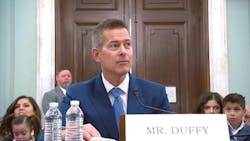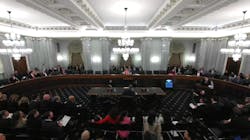Senate hearing: How DOT’s next leader will manage motor carriers
Sean Duffy, Donald Trump’s nominee for Secretary of Transportation, answered senators’ inquiries Wednesday on how he would manage the Department of Transportation.
Members of the U.S. Senate Committee on Commerce, Science, and Transportation questioned Duffy on a wide range of transportation topics from autonomous vehicles to electric vehicles, ports, aviation, and—most importantly—safety.
“Together with President Trump, this committee, and the entire DOT team, we will usher in a golden age of travel,” Duffy told senators.
How will Duffy’s management of DOT affect motor carriers? Here is everything the former congressman told the senate committee this week as it applies to trucking.
Pursuing a legacy of safety
Safety was the key word for Duffy’s answers during the Senate hearing. He repeatedly answered questions with an emphasis on following commitments safely. The secretary nominee said that he would most want his legacy as transportation secretary to be for safety.
“Safety is paramount. Every year, 40,000 lives are lost in roadway accidents,” Duffy told senators. “If confirmed, I’ll prioritize road safety, ensuring lives and families aren’t forever changed by preventable accidents.”
To that end, Duffy told senators he would consider pushing the National Highway Traffic Safety Administration to continue rulemakings on the development of crash test dummies and the implementation of inebriated driver detection technology.
Duffy also resolved to reduce distracted driving and “figure out a pathway forward to make sure these youngsters, and every American, is making sure they’re paying attention to the roadway and not their phones or something else in their vehicle.”
The nominee stressed, however, that such technologies should continue to respect citizens’ privacy.
See also: CARB withdraws Advanced Clean Fleets bid
Reduce regulatory burdens
Reducing the impacts of permitting and regulation is a key priority of both the incoming president and the new Congress. Duffy affirmed that he would also work to reduce regulatory burdens and quicken development.
“If confirmed, I will work to reduce the red tape that slows critical infrastructure projects, ensuring funds are spent efficiently and we use the tax dollar well,” Duffy said.
The DOT nominee also pointed to expediting approvals from the National Environmental Policy Act.
“The length of time it takes to do projects is way too long. The NEPA process is complicated and time-consuming. We don’t have to trade in making sure we’re protecting the environment to do projects,” Duffy said, affirming that he would commit however he can to speed up approval processes.
He also promised to focus on building efficiency within the DOT to develop road infrastructure more quickly.
“I will do everything in the power of the Department of Transportation to move the process forward as quickly as possible,” he said.
Funding for surface transportation
Duffy told senators he was committed to distributing funding to support the development and maintenance of surface transportation infrastructure.
The nominee committed to executing the Infrastructure Investment and Jobs Act and getting its funding out more quickly. He also shared his thoughts on the problem of funding the Highway Trust Fund.
The Highway Trust Fund’s income relies on fuel taxes. As vehicles become more fuel efficient or use electricity in place of fuel, the fund’s revenue cannot keep pace with its expenses. The Highway Trust Fund faces a budget deficit of millions of dollars over the next few years.
Duffy said that he thinks EVs should pay into the fund in some way.
“They should pay for use of our roads,” the DOT nominee said. “How to do that is a little more challenging.”
He pointed to three likely scenarios to pursue funding from EVs.
“You can increase the gas tax … we could increase tolling, or there’s a mile-driven formula that could be used as well. My concern with that, though, is the privacy around American citizens,” Duffy said. “I think that is a conversation that will fall within the purview of this committee, but I would be happy to work with you.”
Centralized autonomous vehicle rules
Autonomous vehicles do not yet have federal regulations. Duffy told senators that he wants clear rules that allow for national innovation.
“Right now, we have a patchwork of laws from state to state. I believe it has to be a federal law by which all of these innovators can abide, no matter whether they’re in Texas or California or somewhere else,” he said. “I will make sure safety is key, but after safety we want to give a wide runway for these companies.”
Reviewing young driver apprenticeships
Despite an hours-long hearing across all facets of transportation, senators only asked Duffy one question about how he would manage the nation’s motor carriers: whether he would review FMCSA’s implementation of the Safe Driver Apprenticeship Pilot Program.
Senator Todd Young (R-Indiana) led sponsorship of the bill, which allows some adults younger than 21 years to achieve a CDL and operate within select states. Young thought that FMCSA failed to properly execute the program as directed by the Infrastructure Investment and Jobs Act.
“There are vested interests that don’t want us to solve the driver shortage problem,” Young said to Duffy at the hearing.
Duffy committed to reviewing implementation of the program and making sure its execution aligns with the language of the law.
About the Author
Jeremy Wolfe
Editor
Editor Jeremy Wolfe joined the FleetOwner team in February 2024. He graduated from the University of Wisconsin-Stevens Point with majors in English and Philosophy. He previously served as Editor for Endeavor Business Media's Water Group publications.


